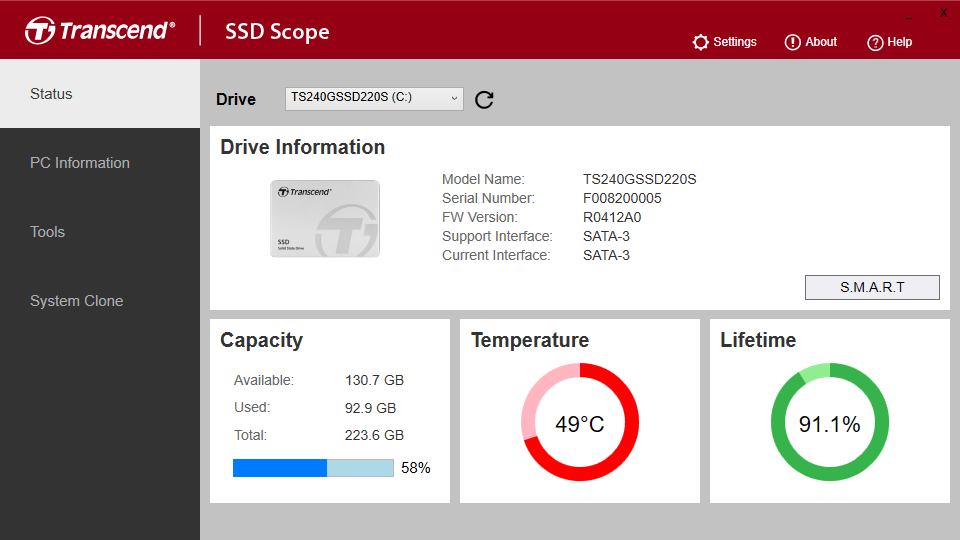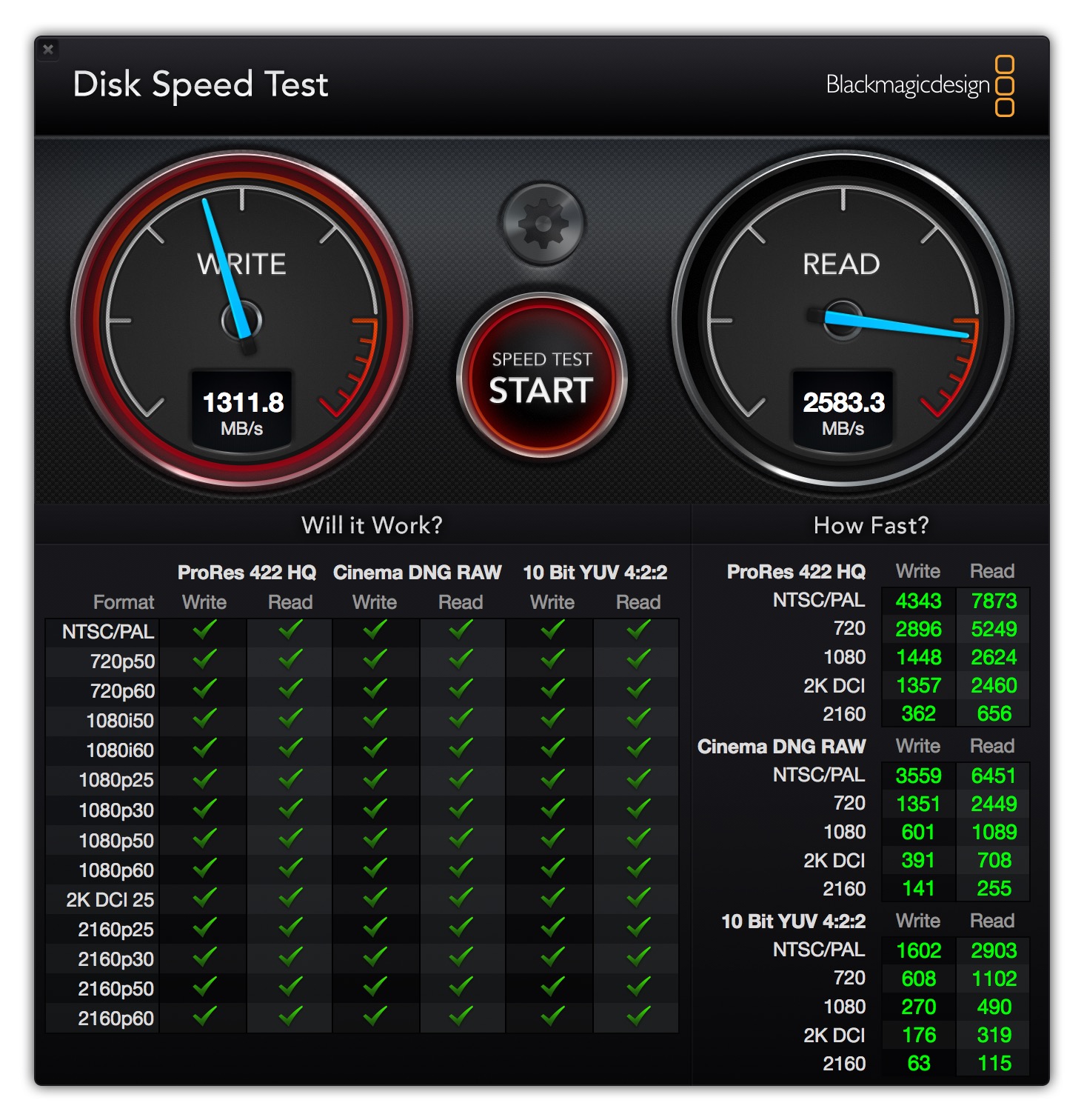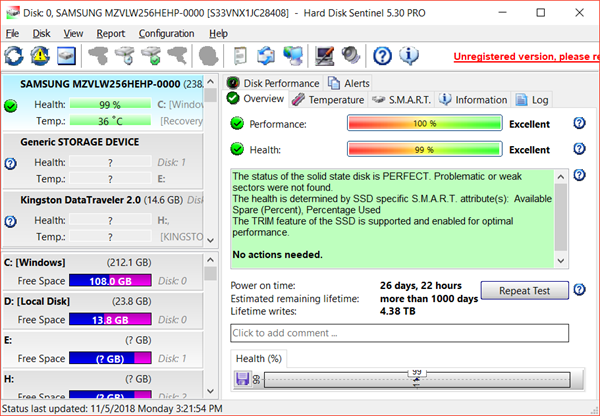SSD or Solid State Drive are now replacing Hard Disk Drive with a high accuracy and are keeping the promise as a high-end alternative to the latter. And as we all know, when comparing SSD and HDD, the former has got very high efficiency when collating with the hindmost. SSD has no spinning components while the traditional HDD and floppy disks have spinning disks and thus SSD are typically more resistant to sudden physical shocks, have quicker access time and lower latency. These are consuming very less battery power with very high-speed working and thereby guarantee your laptops more battery life.
Since SSD store data in electrical charges which can slowly leak over time and this causes worn out drives, that had passed their tolerance rating. And we know, these are just two devices and protection act is all on us. If you really care about your SSD, I just recommend following this article so that you can check the health status of your device.
Top 5 SSD Health Test Tools for Windows
#1. AS SSD Benchmark
The Crucial Mac Scanner will run and open with results in your default browser. Once you are done, simply delete the file since nothing was installed or created on your computer. Removing the Scanner is easy. Just delete the CrucialScan.exe file that you downloaded. The scanner does not install anything on your system.
- SMART Self-Test Log Structure error: invalid SMART checksum. SMART Self-test log structure revision number 1 No self-tests have been logged. To run self-tests, use: smartctl -t Selective Self-tests/Logging not supported The exact parameters and stats shown for your SSD might vary, but as it's a free tool, you can try and see for yourself!
- Intel SSD Toolbox – Intel's SSD tool works with a wide range of Intel SSDs, including Intel Optane SSDs as well as data center, enthusiast and consumer products, providing monitoring or adjustments such as: Model number, capacity, and firmware version.
- Apple’s Mac lineup consists of MacBook, MacBook Air, MacBook Pro, iMac, Mac Pro, and Mac Mini. The Mac runs macOS for its operating system.
It is one of the top-ranked software to check the status of your SSD. There won’t be any compromise to the speed of the disk at which it operates and you need to ensure that all times. With this software, one can test random read and write performance as well as sequential read and write performance. Note that both these tests can be done without the use of a cache. With the help of 1 or 64 threads, the software tries to determine the SSD’s access time. The synthetic tests carried out will determine sequential and random read and write performance of the device.
In the sequential test procedure, the software measures the time to read and then write exactly 1 GB size file. In 4K test, a randomly selected 4 KB blocks of memory are chosen to study the read and write performance of SSD. Yet another test determines the way 4 KBs of data are read and written but when operations are dispensed to 64 threads. After all series of tests carried out this software, it ultimately generates a score so that you can compare one SSD to another. Thanks to the user-friendly output which is of a graphical format and easy to understand. The software also provides a graph for the performance of SSD as a function of compressibility of data which is again a useful result.
#2 CrystalDiskInfo
Crystal disk info software lets you know about the health status as well as the temperature of your SSD device. The software is also called SMART technology, which is expanded as Self-monitoring, Analysis, and Reporting Technology. The screen will read you on the dashboard a list of various system data which are abreast. At a glance, you can determine whether things are working properly or not. It allows you to receive notifications as mail or sound alert if something goes wrong inside the system. Additionally, you can also choose the data to be refreshed at regular intervals.
I should have to mention that a person using this software must have some technical background. If not it will be difficult to interpret the data displayed on the screen. Health status and temperature are displayed on the top of the interface and at the bottom. You can also find values for monitoring, reporting, and real-time analysis. Surprisingly, it is quite annoying to note that there is no help for any of the data displayed. One has to find all by yourself. The software has two versions where one can be installed and other is portable.
#3 CrystalDiskMark
CrystalDiskMark is yet another option for a regular computer user to check his SSD status. It thoroughly tests various parameters before reaching a conclusion. Basic read and write speed are calculated by the unit Megabytes per second and the software also tells you about disk operations. The range of CDM to run the check is from 50 MB to 4 GB and the user is allowed to choose the number passes to accommodate in between check. This software won’t put the RAM under high stress but make sure that no documents are open while the checking process is going on.
While using the software, the user has the freedom to choose the data either in binary format or to arbitrarily feed the data. One can manually select the number of test runs, the size of the test and the drive that need to be checked. A sequential test, 4K test, 512K test and 4K queue depth test are possible using CDM software. It is quite interesting to note that CDM only requires less than two minutes to complete every test but for a higher accuracy, you are recommended to close all other apps. The main window will display the test results in a user-friendly format.
#4. SSD Life
The software analyses how often and active you use your SSD with the use of an algorithm to calculate the lifetime of your drive. The software allows you to create a backup of all data that you have before the drive dies. It also informs you about the serious threats found on your drive. You can find information about the written and read data on the drive. Hence it is easy for you to find the longevity of your device. One can also find the time of the drive for which it has been in operation along with other details which are technical in nature, like TRIM support and more.

SSD Life is compatible with almost all SSD’s that are in use from time-proven first Vertex models to the latest Intel models. SSD life software has proven its validity as testing with solid-state drives from manufacturers like Kingston, OCZ gave a handy result. Note that free versions can keep report only for 30 days and it can’t show the SMART attributes in the program window. So try this software and control how safely and securely data is stored in them.
#5. Intel Solid State Drive Toolbox
It is a drive management software that enables you to view all current drive information for Intel SSD which may include the model number, drive health, estimated drive time remaining, SMART attributes and to identify device information. It allows you to have a garbage collection that can be triggered at regular intervals of time. Using TRIM functionality, one can optimize the performance of an Intel SSD. One is able to get a proactive notification of new Intel SSD toolbox and can update the firmware on a supported Intel SSD.
Net setup for mac windows 7. As other health check software, this particular stuff can very well run haste and complete diagnostic scan to test the functionality of an Intel SSD. It enables you to view your information regarding system and hardware configuration such as chipset, driver versions, and controller name. It is easy to check and tune system settings for power efficiency and optimal performance. Note that you should turn off drive password protection prior to firmware update process or else Intel SSD may reject the update request.
Now with all these software to check the health status of your SSD, there is no point to be ashamed while you lose data on a worn out SSD. Tap any of the links, download it, control your SSD and make sure that your data are safe and secure. Let me know the other best software for the same purpose from my patient audience.
If you think your Mac might have a hardware issue, you can use Apple Diagnostics to help determine which hardware component might be at fault. Apple Diagnostics also suggests solutions and helps you contact Apple Support for assistance.
Remove Little Snitch App Completely From Mac OS Dragging the application to Trash folder will remove the application, but, unfortunately, not all the core files of Little Snitch are deleted and the files still reside on your Mac. Also, All-in-one installers like AppZapper and AppCleaner may often fall short with complex applications. Here is how to delete Little Snitch for Mac, using its own uninstaller: Open the “LittleSnitch-4.0.5.dmg” file. Make a double-click and choose the Little Snitch Uninstaller. Select Also remove rules and settings and click the Continue button. Little Snitch; How to Remove Little Snitch in Mac OS X. This article is teaching you how to correctly remove Little Snitch in Mac OS X. Before performing the removal, let’s get to know more about Mac OS X, so that we will be able to safely, completely remove Little Snitch. Over the years, Mac OS has never given up on the desktop market. Click on the “X” icon that looks on the kept upper part of Little Snitch Construction, and go through the Delete button in the verification dialog. If you set up Little Snitch Construction through the App Store, as well as your system is Operating-system X lion or later, you may take this process to uninstall it. Mac Basics, Help and Buying Advice. I have recently installed little snitch, later i prefer to uninstall that, because, whenever i open any application. 

Prepare your Mac
- Shut down your Mac.
- Disconnect all external devices except keyboard, mouse, display, Ethernet connection (if applicable), and connection to AC power.
- Make sure that your Mac is on a hard, flat, stable surface with good ventilation.
Start Apple Diagnostics
Determine whether you're using a Mac with Apple silicon, then follow the appropriate steps:
Apple silicon
Ssd Test App Mac
- Turn on your Mac and continue to press and hold the power button as your Mac starts up.
- Release when you see the startup options window, which includes a gear icon labeled Options.
- Press Command (⌘)-D on your keyboard.
Intel processor
Ssd Testing Tool For Macbook
- Turn on your Mac, then immediately press and hold the D key on your keyboard as your Mac starts up.
- Release when you see a progress bar or you're asked to choose a language.
View the test results


The art of time management. Apple Diagnostics shows a progress bar while it's checking your Mac:
When testing is complete, Apple Diagnostics shows the results, including one or more reference codes. Learn about Apple Diagnostics reference codes.
To repeat the test, click “Run the test again” or press Command-R.
To restart your Mac, click Restart or press R.
To shut down, click Shut Down or press S.
To get information about your service and support options, make sure that your Mac is connected to the internet, then click ”Get started” or press Command-G. Your Mac will restart to a webpage with more information. When you're done, choose Restart or Shut Down from the Apple menu.
Learn more

On an Intel-based Mac, if you can't start Apple Diagnostics with the D key, try these solutions:
Ssd Testing Tool For Macbook Pro
- Press and hold Option-D at startup to use Apple Diagnostics over the internet.
- Make sure that your Mac isn't using a firmware password.